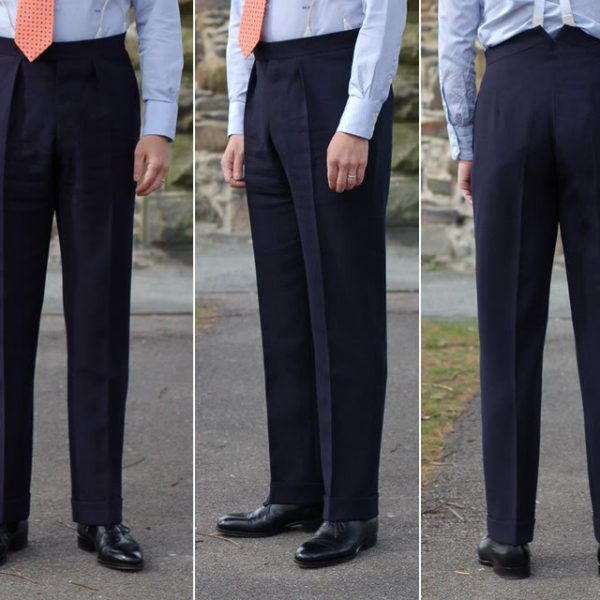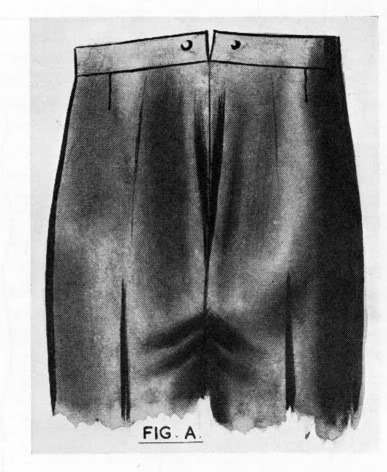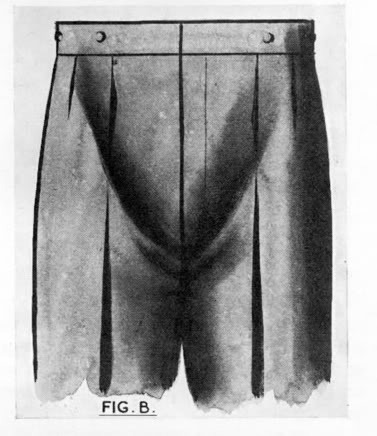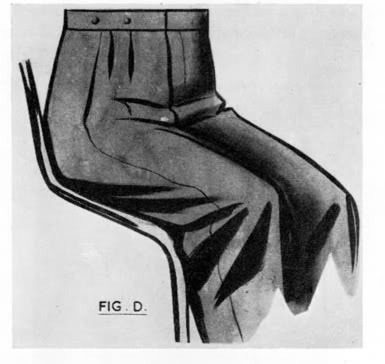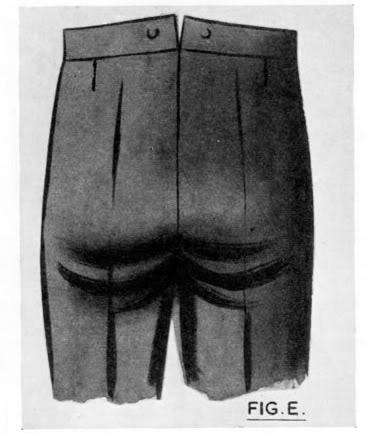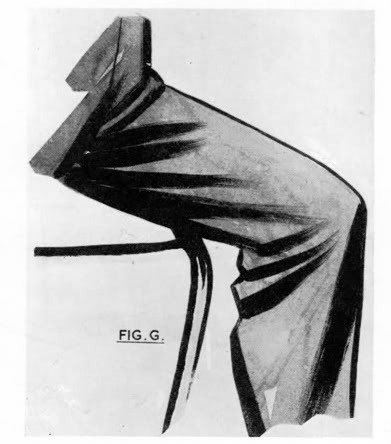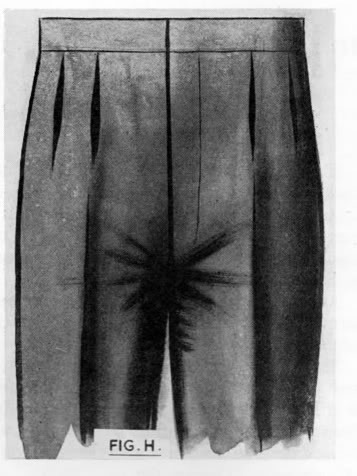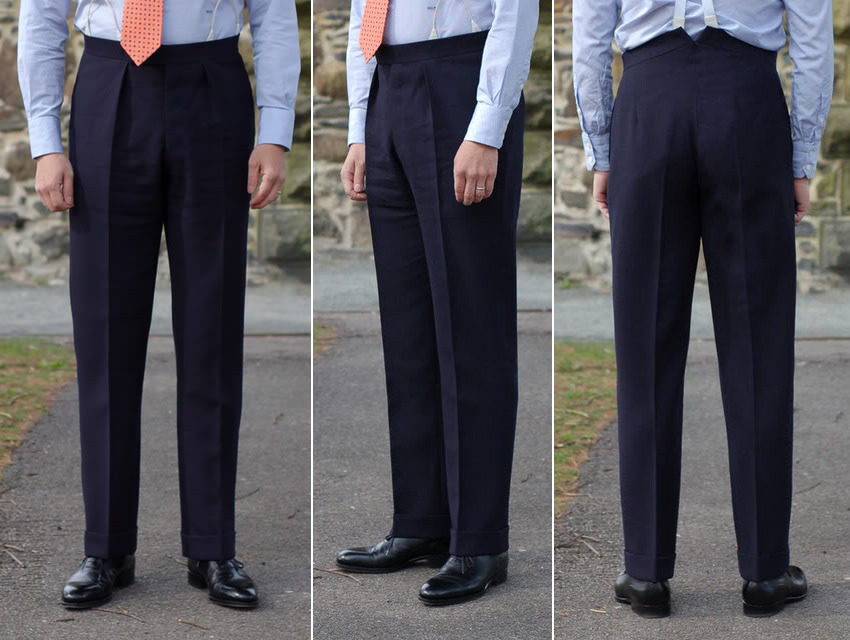
It’s much easier to get trousers to fit well than jackets. There’s also less wiggle room for interpretation. While there are different schools of thought on how a jacket should fit, trousers should only fit one way. There shouldn’t be any puckering or pulling along the seat, waist, fronts, or back, and there shouldn’t be any ripples along the legs. Instead, there should be a completely uninterrupted line going from the top to the bottom, both along the front and back of the trousers. If there is a break, the maximum number is one, and if there are pleats, they should remain closed at all times. Regardless of their style (slim, tapered, straight legged, full, etc), these points should remain true for any classic pair of men’s trousers.
Though it’s easier to find well fitting pants, that doesn’t mean it’s always accomplished. Most men’s trousers suffer from any number of problems. Above is a color photograph that shows how a pair of well fitting pants should look. Below that are a number of black and white diagrams posted by Tutee on StyleForum, each of which demonstrate some common defects. If you click on the diagrams, they’ll expand and you’ll see that they’re lettered.
- Fig A. Roping Along Seat Seam: Here there’s tightness in the seat seam, which is drawn tautly up the center. Vertical folds thus appear.
- Fig B. Diagonal Creases from Fork to Side Seam: This is more often than not something you see on corpulent or semi-corpulent figures. The defect unfortunately emphasizes the contour of the wearer’s stomach, which is of course the last thing a stout gentleman would want.
- Fig C. Vertical Folds at the Fork: The fork is the area of your body that joins your legs to the trunk. Here, folds of excessive material are seen around the fork, and they run towards the inside of the leg.
- Fig D. Excess Material in the Lap: This was made into a pretty funny scene on Curb Your Enthusiasm. Obviously, there will always be a certain amount of excess material in the lap when the wearer is seated. This is what allows your pants to fit well when you’re standing up. However, if there is too much material, it should be considered a defect (note: I’ve found zippered flys to be worse offenders than buttons in these cases).
- Fig E. “Horseshoe” Folds: Perhaps the most common defect is when excessive material folds near the fork, around the seat of the pants. There may also be diagonal drags running down the inside of the leg.
- Fig. F. Fullness Under the Seat: Similar to Figure E, there can also be excessive material under the ball of the seat. This material can sag away from the wearer.
- Fig. G. Drags from Fork to Knee: Here, when the wearer is seated, creases extend from the knees back towards the fork (again, where the leg joins the trunk of your body). There is also a slight pull from the knee bone to the back of the leg.
- Fig H. Horizontal Creases at the Fork: This can occur either in the front or the back. Tutee notes that this is also common in old trousers, especially ones that haven’t been pressed or re-shaped occasionally.
A number of things that can cause these defects. The seat angle might be too low or high; there could be insufficient or too much room in the trunk or fork; the leg seams can be too open or closed; or the legs can be placed incorrectly from the fork.
There are remedies, but many of them involve details that are only of interest to tailors and those who commission bespoke clothing. For most people, whether some of these are fixable through an alterations tailor depends on what exactly is causing the problem. For example, if there is fullness in the seat, there could be just excess material. In this case, if it’s not too much material, a tailor can most likely take it in. If it’s a result of an incorrect seat-angle, however, this will be much more difficult.
So what can you take away?
- Well first, you should use the color photograph above as a model for how trousers should fit. Perhaps you like them skinnier or fuller, or you like to wear belts instead of braces. Either way, you can see here what it means to have “clean lines."
- Second, keep the diagrams in mind so you know what to look for when trying on pants. As with almost all off-the-rack clothing, it’s nearly impossible to get something to fit 100% perfectly, so expect that there will be issues. You just want to minimize the defects.
- Third, if a pair of trousers doesn’t fit, your best bet is to try on either the size above or below, and see if the problems aren’t remedied. Notice here that almost all the problems occur between the waist and the thigh. Buy pants that fit you best in these areas. Most of the time, you’ll be able to alter the waistband and calves. If the trousers still don’t fit after you change sizes, that specific cut simply doesn’t fit you, so move on.
And that’s how pants should fit.
* This post owes itself to Tutee, who has been a remarkable contributor on every major classic mens’ style community.
